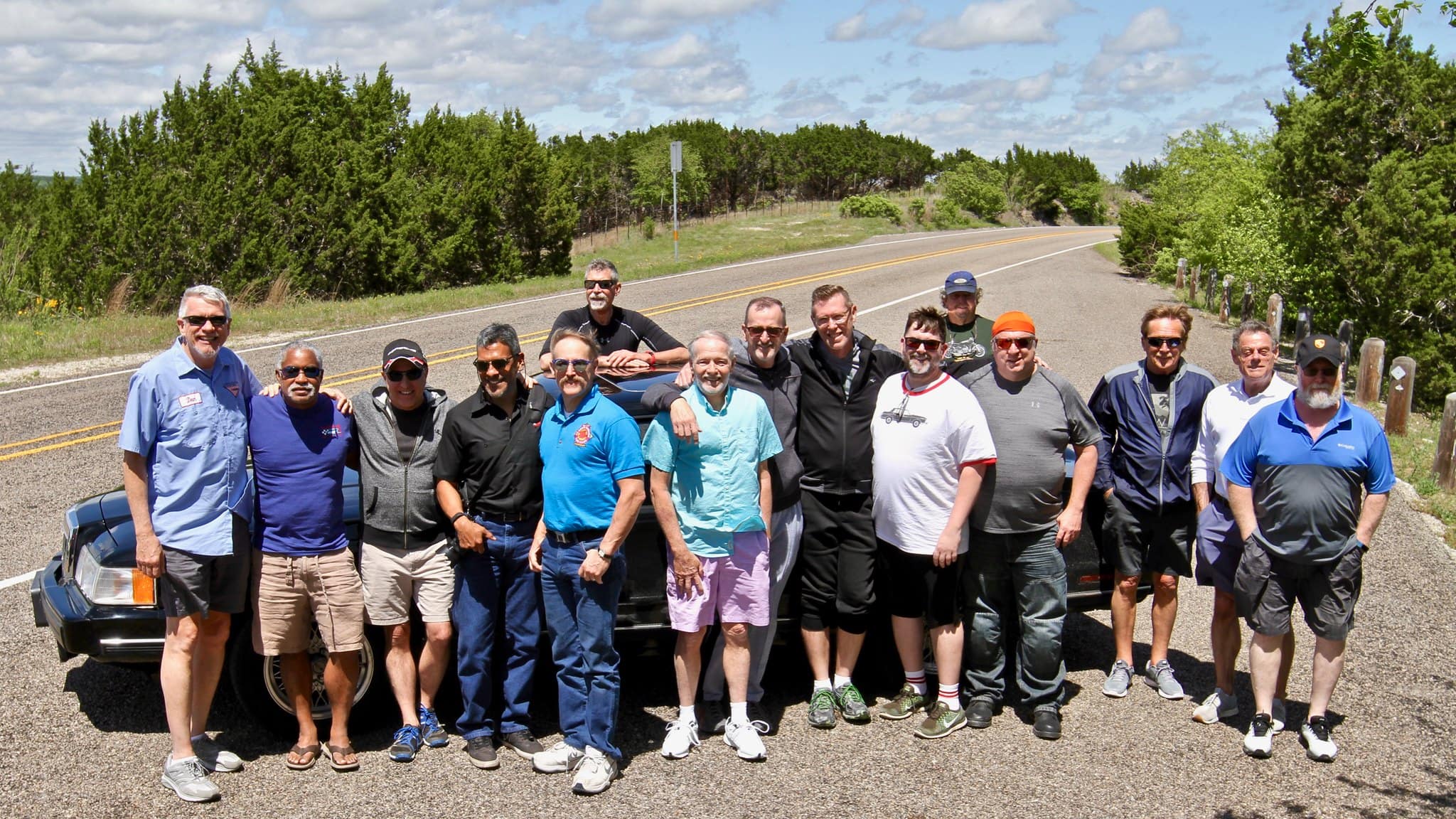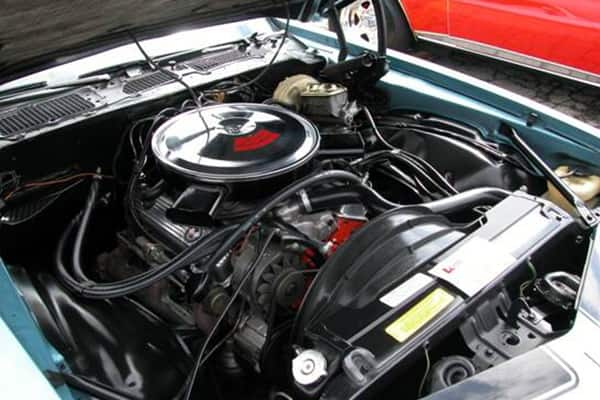From timeless icons to everyday essentials, Crucial Cars examines the vehicles we can't live without.For this installment, we explore the amazing and iconic Chevy Corvette.
CNN writes, “Even for folks who don't care about cars, the Corvette matters. It's historic . . . The sleek silhouette has transformed into a pop culture icon across TV, films and advertising." That pretty much sums up the appeal of the Chevrolet Corvette. It's been the quintessential American sports car for well over 60 years, making it the longest continuous production history of any American car, yet it's still within reach for folks on a middle-class salary. Its place in pop culture has been solidly staked out for some time...don't forget Prince's 1999 hit "Little Red Corvette" and the 'Vette's numerous appearances in movies and TV, including a starring role in the early-60s series "Route 66."
Corvette's appeal
Ironically, the Corvette wasn't originally intended for mass production and there was a time in its early history when it looked like it might not even stick around in the Chevrolet lineup. In the early 1950s, General Motors was the largest corporation in the world, manufacturing more than half of the cars driven in the entire United States. Thing is, nothing in the GM lineup from Chevrolet, Buick, Cadillac, Pontiac or Oldsmobile even remotely resembled a sports car. In the fall of 1951, GM's chief designer, Harley J. Earl, saw a market niche that was being taken up by British sports cars, favorites of WWII veterans from their time in Europe. In addition, Earl was aware of the fiberglass-bodied two-seater Kaiser-Darrin and had heard rumors that Ford was working on an open two-seater (which came to be the Thunderbird). Earl began to brainstorm about an open sports car that could be offered at about the same price point as a family sedan, which was $2,000 (around $20k in today's dollars).

Harley Earl and one of his concepts, a 1956 Firedbird II | GM
Robert F. McLean, who started work using standard parts-bin Chevy bits, including the "Blue-Flame" inline valve-in-block six and a live-axle rear suspension. According to Edmunds.com, “The chassis and suspension were for all intents and purposes the 1952 Chevy sedan's, with the drivetrain and passenger compartment shoved rearward to achieve a 53/47 front-to-rear weight distribution over its 102-inch wheelbase.
The engine was essentially the same dumpy inline-6 that powered all Chevys but with a higher compression ratio, triple Carter side-draft carbs and a more aggressive cam that hauled its output up to 150 horsepower. Fearful that no Chevy manual three-speed transmission could handle such extreme power (there were no four-speeds in GM's inventory), a two-speed Powerglide automatic was bolted behind the hoary six."
GM planned to showcase this vehicle at the Motorama exhibit of the 1953 New York Auto Show, testing the waters to gauge public interest. Then, GM's chief engineer, Ed Cole, saw the sweet, rakish-looking vehicle and recognized its huge potential – and production preparation began so quickly that it started before the New York show even began. Once the car was displayed to the public, show attendees were fascinated by it.
Six months later, on June 30, 1953, the first Corvette rolled down the assembly line in Flint, Michigan. The '53 models were slow sellers, though. Handling and overall roadability were pretty rough on the early production models, performance was lackluster and Chevrolet soon found out that forming the contours of the fiberglass body was a labor-intensive process. Fit and finish was spotty, the two-speed Powerglide automatic wasn't a favorite of sports car buyers and braking left something to be desired. The first year, only 300 copies of the Corvette were produced, making it a super-scarce unicorn in today's collector car scene. At one point, GM actually considered shelving the project entirely, but that soon changed thanks to a few different factors.

1957 Corvette | Wikimedia Commons
The Corvette Hits Its Stride
In '55, Ford introduced the Thunderbird and Chevrolet was not about to back down from that challenge. In addition, Chevy introduced the 265 V8, the first modern overhead-valve V8 engine from the division, and the Corvette could now be fitted with a 195 hp engine, a huge improvement over the 1940s-era flathead six. A new factory was built in St. Louis, dedicated to Corvette production lines, the V8 'Vette was offered with a three-speed manual transmission and the original white paint scheme was expanded to a palette of five colors.
1955 was also the year that Russian emigrant Zora Arkus-Duntov was put on the Corvette team. He was interested in the car from its inception, and his white paper titled "Thoughts Pertaining to Youth, Hot Rodders and Chevrolet" was responsible for a big change in the company's direction. In addition, Arkus-Duntov made quite an impression with a technical paper on how to calculate the Corvette's top speed without the need to the car to a test track. By 1957, Arkus-Duntov was named Director of High Performance Vehicles at Chevrolet. Thanks to him, the 'Vette was soon available with mechanical fuel injection and a fat camshaft. In '57, he hit a record-setting 150 mph in the flying mile at Daytona Beach behind the wheel of a Corvette.
Through the rest of the 50s, performance continued to spike with the introduction of the 283 V8, which could be tuned for as much as 290 hp. Chevrolet offered the Corvette with a race-ready package that included cold-air induction, a tachometer, stiffer suspension, beefier brakes and 15.5" wheels. By '58, the 'Vette sported the same quad-headlight arrangement as many other GM products. Starting in model year '62, the Corvette was available with the famed 327 V8, which offered anywhere from 250 to 360 hp depending on the performance package ordered.
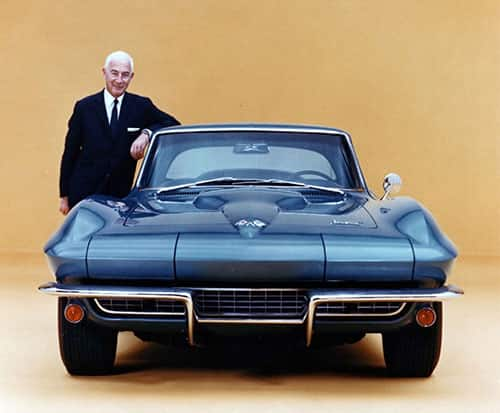
Zora Arkus-Duntov with a 1966 Corvette | GM
The 60s
In the mid-50s, Bill Mitchell at Chevrolet was working on the Sting Ray and Q-Corvette concept cars. The Sting Ray was race-oriented, while the Q-Corvette was loaded with advanced features like a rear transaxle, independent rear suspension, four-wheel disc brakes and more. Meanwhile, Arkus-Duntov was toying with more exotic ideas like a mid-engined Corvette or even a rear-engine design that would use the air-cooled flat-six from the Corvair.
In the end, Chevrolet used wind-tunnel testing (for the first time with the Corvette) to come up with a slippery fastback body. The frame was a lot more robust and rigid, so the thickness of fiberglass body panels could be reduced; the new 'Vette actually ended up a little lighter despite the chunky frame. The new-generation Corvette rode on a 102-inch wheelbase, the same as the Jaguar XK-120, and the overall look was eye-catching with a knife-edge front end, long hood and concealed headlights. In back there was a big rear glass split by a bar down the middle, inspired by Bugatti. The doors were cut into the roof for ease of entry and exit, and the combination of better weight distribution and a stiffer frame meant much-improved handling. The archaic 1950s live axle suspension was gone, replaced by an independent rear suspension and a frame-mounted differential with half-shafts going to the wheels.
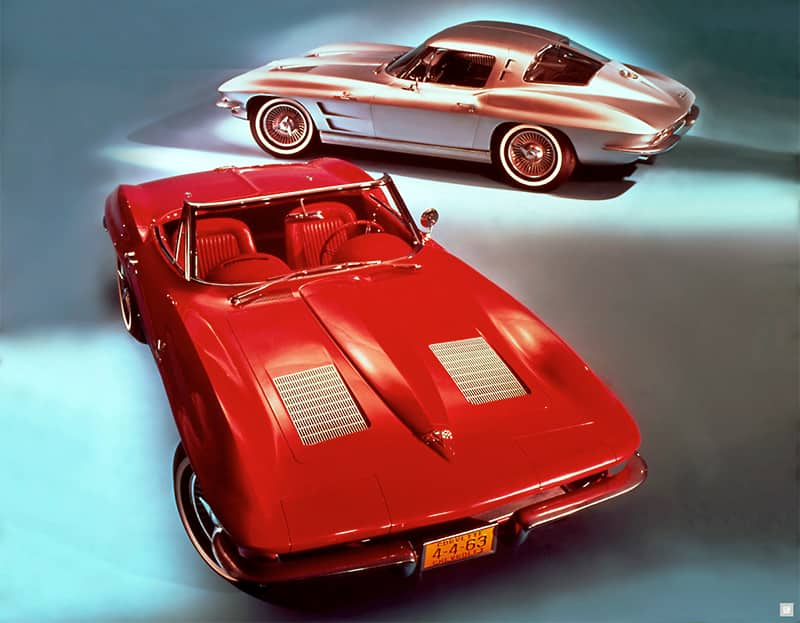
1963 Chevrolet Corvette Sting Ray Coupe and Convertible | GM
Under the hood, buyers had their choice of four 327 V8s, ranging from 250 to 360 hp. The standard transmission was a three-speed manual, although a two-speed Powerglide or close-ratio Borg-Warner four-speed manual could be had. The split-window rear glass was done away with in '64 due to visibility concerns, making a split-window 'Vette rare indeed today. Dubbed the Sting Ray, the '63 model saw a 50 percent jump in sales over the previous year. Other minor changes were worked in for '64, and then by '65 the Corvette could be ordered with a monster 425 hp 396 c.i. big-block V8. The big-block spelled the end of the expensive fuel injection option for the 327 engine. With all that go-power came improved stop-power as well; the '65 model was available with an advanced four-wheel disc brake setup, with four pistons per caliper and slotted rotors for cooling.
1967 was the final year for the C2 version of the Corvette, and was also the first year for the L88 version of the 427 V8. The L88 offered 430 hp, although some estimates place it as high as 460 hp; only 20 were produced, though. There was also a lightweight all-race version that came out in '67, as an answer to the Shelby Cobra. Only five were sold, to luminaries like A.J. Foyt and Roger Penske, and all five survive to this day, making them a Holy Grail of Corvettes.
Third Generation (1968-1982)
Ever wondered where Chevrolet designations like LT-1, Z07, and ZR-1 originated? You can thank the third generation of the Corvette. The '68 model year was the first introduction of removable T-tops, combining the open-air fun of a convertible with the added body stiffness of a coupe. The following model year saw the end of the 327 V8, replaced by the 300 hp 350, as well as the all-aluminum ZL1 engine. The ZL1 version of the 427, rated at 430 hp, could scoot the Corvette through the quarter-mile in a shade under 11 seconds (and is, of course, very rare today). Amazingly, thanks to the aluminum block and heads, the engine weighed the same as the small-block V8.
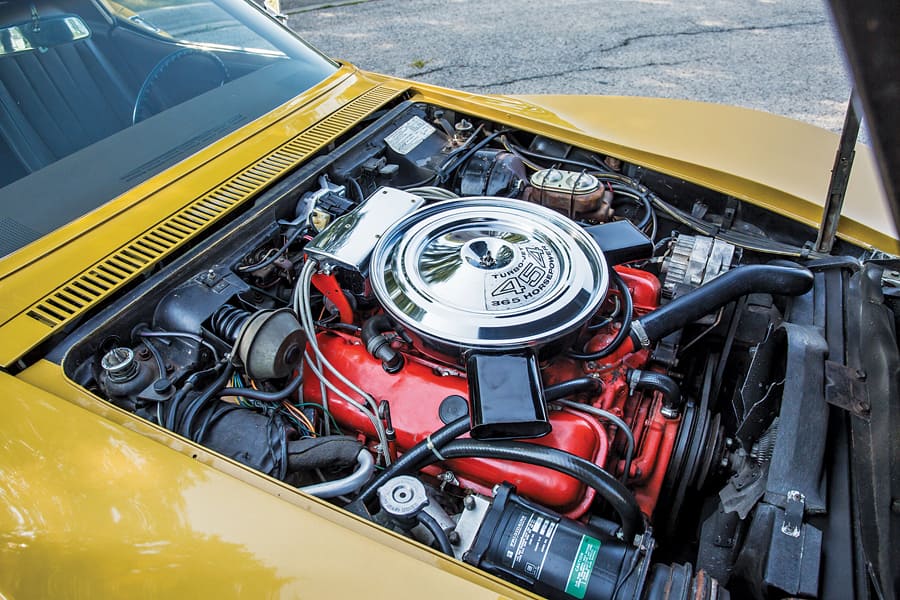
1971 Corvette 454 | American Car Collector | Jeremy Cliff
Model year 1970 saw the end of the 427 big-block V8, replaced by the 454; for 1971, the LS6 version of the 454 was offered. This aluminum-head engine generated 425 hp and was only available for one year. Unfortunately, by '73 the performance game was pretty much over for all muscle cars. The Arab oil embargo, government safety and environmental regulations and spiking insurance rates all came together to put an end to the party. By 1975, the convertible option was gone, and wasn't offered again for another 11 years. The fiberglass floor pan was replaced with steel to protect against heat from the catalytic converter, and dual exhaust was a thing of the past after 1974. By the mid-70s, the Corvette's 350 V8 put out a paltry 165 hp, and in 1979 Dodge's 360-powered Little Red Truck was the fastest production vehicle in the United States.
It wasn't all bad news for the Corvette, though. In '78, a Corvette was the Indianapolis Pace Car for the first time, and by the end of the 70s the body had been subtly restyled for better aerodynamics (including a fastback rear glass).
Fourth Generation (1983-1996)
Model year 1983 saw the first full redesign of the Corvette since 1963. The fourth-gen 'Vette featured advances like:
- an all-aluminum suspension for weight savings
- body panels made from specialized sheet plastic rather than fiberglass
- electronic dashboard with LCD displays for speedometer and tach
- transverse mono-leaf spring in front, replacing coil spring suspension
- Doug Nash manual transmission with electronic overdrive (replaced in 1989 by a 6-speed manual)

1987 Corvette | Wikimedia Commons | Sicnag
In addition, horsepower started creeping back up in the 80s and 90s. By 1990, Chevrolet had collaborated with Lotus and Mercury Marine to develop the LT5, an all-aluminum, 32-valve DOHC V8 that was capable of 375 horsepower. This variant included innovations like a tire pressure monitoring system and active suspension that could be adjusted for response on the fly. The result was a Corvette with 375 hp (boosted to 405 hp in later iterations), capable of 0-60 in under five seconds and a 13-second quarter-mile. On the down side, it was priced at nearly $60k (equivalent to over $110k today), putting it in Porsche 964 territory and making it a tough sell for Chevy dealers.
Fifth Generation (1997-2004)
The '97 model year of the Corvette brought a total redesign from the ground up. In retrospect, the C5 generation of the Corvette was probably the best up to that time: better handling, fantastic performance, nicer ride quality and amenities, safer and (incredibly) up to 28 mpg on the highway, even with the 345 hp LS1 engine. The new engine was all-aluminum and featured coil-on-plug ignition for the first time, and could get the 'Vette up to a top speed of 176 mph.
Model year 1997 also saw the return of the convertible, and a revamped body with a drag coefficient of a slippery .029. There were innovations that were far ahead of the curve, like electronic stability control, electric power steering and a new active suspension setup. With the high-performance Z06 option, the Corvette could do a 0-60 run in four seconds flat and covered the quarter-mile in 12.4 seconds. The Z06 engine, with its 406 hp, included goodies like higher compression, a more aggressive cam profile, enhanced air intake volume and lighter sodium-filled valves.

C6 Corvette | Wikimedia Commons
Sixth Generation (2005-2013)
The Corvette continued to evolve and be refined for its sixth generation, with an all-new 6.0 liter V8, overhauled bodywork, redesigned suspension geometry and a roomier interior. In 2008, that 400 hp 6.0 liter V8 was joined by a 430 hp 6.2 liter engine, dubbed the LS3. In addition, the small-block V8 was bored out to 7.0 liters (427 cubic inches, ironically enough) that was tuned for 530 hp, making it the most powerful naturally-aspirated V8 ever from Chevrolet.
In addition to a phenomenal selection of engines, the C6 worked in some interesting weight-saving innovations, including:
- Aluminum frame
- Magnesium alloy engine cradle
- Titanium alloy engine parts
- Carbon fiber body panels
- Balsa wood/carbon fiber composite floor pan
The result was a power/weight ratio of 6.2 pounds per horsepower , and phenomenal performance: Car & Driver recorded a 0-60 time of 3.6 seconds and a quarter-mile of 11.7 seconds at 125 mph.
There were even higher-performance iterations of the C6 Corvette in limited numbers, including the 630 hp ZR1 (with a supercharged LS9 engine) and a Carbon Edition, with many ZR1 parts and more use of carbon fiber. It's believed only 250 Carbon Edition models were built.
Interestingly, the C6 Corvette was also the basis for the Cadillac XLR luxury roadster. Introduced in '03, this flagship car was loaded with way-ahead-of-their-time innovations like active cruise control and active suspension with magneto-rheological fluid in the shocks. These shocks have magnetic beads in the fluid; sensors monitor wheel motion over a road surface and constantly send magnetic signals to the shocks to change damping according to road conditions, cornering and braking forces.

2015 "LT4" 6.2L V-8 AFM VVT DI SC (LT4) for Chevrolet Corvette Z06 | Chevrolet
Seventh Generation (2014-2019)
The evolution of the seventh generation Corvette started way back in 2007, and it debuted in 2013 at the North American Auto Show. The latest iteration of the 'Vette had an all-new 6.2L small-block LT1 V8, putting out an amazing 455 hp and enabling a 0-60 time of 3.8 seconds. Underneath, the suspension was redesigned to feature transverse fiberglass mono-leaf springs and an updated active suspension with electromagnetic shocks. Styling got a rather controversial makeover as well, with a rear-end treatment that bears more than a passing resemblance to the Camaro.
Chevrolet worked plenty of technological advances into this generation of the Corvette, including:
- Carbon fiber hood and removable roof panel
- Hydroformed aluminum chassis
- Carbon-nano panels underbody
- Functional hood scoop and brake ducts
- Cylinder deactivation and variable valve timing for fuel economy
- Advanced infotainment display that shows things as detailed as tire tread temperature, a performance timer, data recorder, g-meter and video recorder
- Carbon-fiber ground effects package
- Suspension adjustable on the fly for Weather, Eco, Tour, Sport and Track modes
- Optional seven-speed Tremec manual transmission with RPM matching
Model year 2018 saw the introduction of an all-new ZR1 package, including a version of the LT5 6.2L small-block V8 fitted with an Eaton supercharger for 755 hp and 715 lb-ft of torque. The C7 generation was definitely a hit, having been named "Automobile of the Year 2014" by Automobile Magazine and "Performance Car of the Year 2013" by Road & Track.
Eighth Generation (2019-present)
The eighth-gen Corvette was redesigned with a mid-engine drivetrain, calling to mind Zora Arkus-Duntov's idea from decades ago. It's the first mid-engine GM product since the late un-lamented Pontiac Fiero of the 80s, with the LT2 V8 mounted amidships. Externally, the Corvette has been tweaked again with more attention to aerodynamics and weight distribution. There's a conventional trunk behind the engine and in the front of the car, and the suspension can be ordered with a ride height adjustment that adds two inches to the front ground clearance at speeds under 25 mph.
The Z51 performance package raises the engine's output to 495 hp and 470 lb-ft of torque; Car and Driver reports a 0-60 time of a neck-snapping 2.8 seconds. Aerodynamically clean, with a 10% stiffer frame and a state-of-the-art interior, the Corvette's latest iteration is an advanced design for the 21st century.

Recovery after the National Corvette Museum sinkhole | GM
Heartbreak at the National Corvette Museum
Unfortunately, the Corvette was in the news a few years back, not for its stealthy look, but rather for a catastrophe that badly damaged some of the finest specimens. On February 12, 2014 at 5:44 a.m., the National Corvette Museum got a call from their security company, stating that motion detectors had gone off while no one was in the museum. Nobody could have anticipated what they'd see, which was a 40-foot-across and 60-foot-deep sinkhole, large enough to swallow up eight Corvettes worth an estimated $1 million. These vehicles included two on loan from General Motors (first two listed below)and six owned by the museum. Damage-wise, they have been placed into one of three categories: least damaged, significantly damaged or worst damaged:
- 1993 ZR-1 Spyder:
- fewer than 12 ever built
- worst damaged
- 2009 ZR1 “Blue Devil":
- least damaged
- 1962 Black Corvette:
- least damaged
- 1984 PPG Pace Car:
- one-of-a-kind car for Indy Car World Series
- significantly damaged
- 1992 White 1 Millionth Corvette:
- millionth to come off the assembly line
- significantly damaged
- 1993 Ruby Red 40th Anniversary Corvette:
- significantly damaged
- 2001 Mallett Hammer Z06 Corvette:
- one-of-a-kind
- worst damaged
- 2009 White 1.5 Millionth Corvette:
- 1.5 millionth to come off assembly line
- significantly damaged
The rescue operation took exactly eight weeks, with two of the cars difficult even to locate in the rubble. To quote CNN, “One priceless car was crushed. Another, mashed; a third, pancaked. Now, Vette City faces a sinkhole summer." Here is footage of the devastation from a University of Western Kentucky's Engineering Department's drone helicopter.

Recovery after the National Corvette Museum sinkhole | Classic-Car-History.com
The path forward was debated. Restore the vehicles? Concerns over who would do the restoration work and how much restoration could be done to one vehicle while keeping it original killed this option. Turn the sinkhole into a permanent display of its own? Costs to do this proved more monstrous than the hole itself, and so it was filled in.
Editor's note: If you're a proud owner of one of the 1.4 million of these attention-grabbing monsters of acceleration, know that Advance Auto Parts has you covered.
